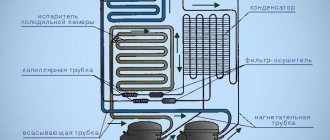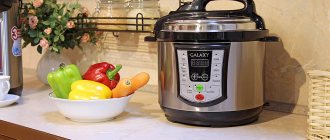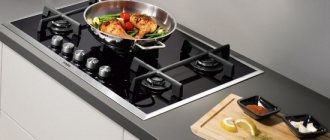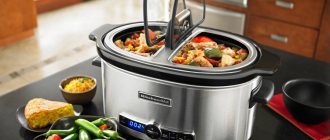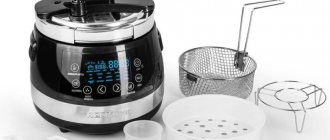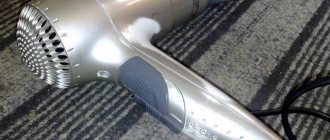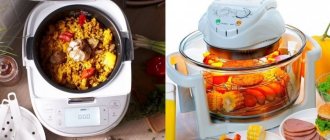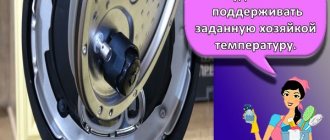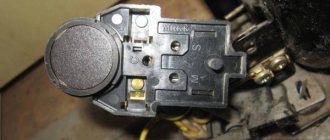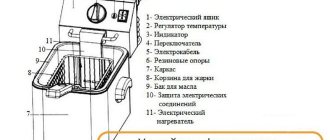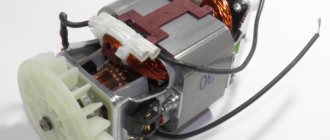A multi-cooker is a household electrical appliance designed to facilitate and speed up the preparation of dishes, both classic and gourmet, multi-ingredient ones.
The kitchen assistant is very popular, because with its help you get tasty and healthy food. Everyone strives to take care of their health as much as possible, therefore, when choosing a multicooker, it will be useful to know how safe the food cooked in it is.
The article will also discuss the design of this technology, operating principle, characteristics, advantages and disadvantages.
What is a multicooker
A multicooker is an electric appliance, the design of which has a bowl that looks similar to a regular saucepan.
The device body is sealed, which is achieved by closing the lid. This is an indispensable technique in the kitchen, which is used to prepare dishes of varying complexity.
Additional functions are designed to make working with equipment even easier
There are built-in programs for this, and automatic ones. The multicooker bowl is made of Teflon or ceramic, so the food does not burn during processing. The device itself is compact in size, so it can be placed in a corner of the work area or on a windowsill without any problems.
Thanks to automatic modes, this “pot” can be trusted to prepare even complex dishes, and does not require human intervention in the process. At this time, you can go about your business.
Despite its compact size, the multicooker “works” with many recipes. The average bowl volume is 5 liters. The number of programs depends on the model, but on average there are 8.
Additional functions are designed to make working with equipment even easier. These are the “delayed start” or “warm up” options. When the electrical appliance starts cooking, you don’t even need to stir the food - the design is designed in such a way as to completely automate the cooking.
The principle of operation of a multicooker
Almost all manufactured multicookers have a similar design. In more expensive models, the equipment is expanded, which gives household appliances additional functionality.
Heating element in the multicooker device
The operating principle of electric multicookers is based on a microprocessor that maintains constant pressure and a set temperature in the bowl, and also monitors the evaporation of liquid.
A multicooker is an intelligent device - based on the products placed in the bowl, it will automatically determine the required time for cooking them.
Briefly, the operating principle of the household assistant is as follows: the pressure in the container is regulated by a special valve, the tightness prevents air from entering the bowl, and the microprocessor sets the temperature values.
Many multicookers are equipped with a removable power cable - this is convenient for taking it with you on the road. Once the equipment is connected to the network, the buttons on the operating panel will light up. Some models emit a beep during startup.
The difference between multicookers available is how they heat food. Happens:
- heating by heating elements;
- induction heating.
In the first case, a tubular heater is used as a heating element, which, located at the bottom of the bowl, heats the container, and with it the food located in it. For a more uniform heat distribution, in some models the heating element is also built into the lid.
In the induction type of heating, the multicooker bowl is itself a heating element
The user, by pressing buttons on the multicooker body, selects a mode, and the device itself decides how long each heating element will work for the food to cook.
To “read” the readings, the design contains a temperature sensor. Heating elements usually operate in turns, which is necessary to save energy.
Another type of heating is induction. This is an innovation in the world of such household appliances. Here h. Electromagnetic waves passing through it increase the temperature of the container. To better retain heat, the bowls are made thick.
All other actions are the same as in devices with traditional heating elements. There is another name for this type of heating – “gentle mode”.
Electromagnetic waves passing through them are responsible for heating products. This effect does not lead to excess temperature in the bowl, especially since it is airtight, so all ingredients retain their taste and vitamins contained.
Design and principles of operation of a multicooker
Rice. 1. Disc heating element with a temperature sensor in the middle at the bottom of the multicooker
In the middle of the heating element there is a spring-loaded temperature sensor. The heating element and temperature sensor are made of aluminum and must fit tightly to the bottom of the bowl. The distribution of heat flows is shown in Fig. 2:
Rice. 2. Scheme of operation of a multicooker with heating element heating
A voltage of 220V is periodically supplied to the heating element, which causes it to heat up. The heat from the heating element is transferred to the bowl of food tightly adjacent to it, causing them to gradually heat up. The heat from the bowl with food, in turn, is transferred to a temperature sensor that fits tightly to its bottom. The temperature sensor measures the temperature of the bottom of the bowl and transmits it to the heating element control device. Feedback is formed, due to which the set temperature of the bowl is maintained.
To understand how the heating element control device maintains the set temperature in the bowl, let’s look at the graph (Fig. 3):
Rice. 3. Operating principle of the multicooker heating element (heating option 1 - fast)
On the graph, the horizontal axis shows time, and the vertical axis shows the power consumed by the heating element and the temperature of the bowl.
The heating element operates in ON-OFF mode. When the heating element is turned on, it operates at maximum power, and when turned off, it operates at zero power. Those. it either heats to its fullest or doesn’t heat at all. There are no intermediate options.
Let's say we set the temperature to 95 degrees. After starting the program, the control device turns on the heating element and periodically takes readings from the temperature sensor (i.e., measures the temperature of the bowl). The heating element steams at full power until the temperature exceeds the target 95 degrees. As soon as this happens, the control device will turn off the heating element, but the bowl, by inertia, will continue to heat up for some time, which can lead, for example, to milk porridge running away. For example, in the Polaris PMC 0523 multicooker in the MILK PORridge mode at a target temperature of 95 degrees after initial heating, the actual temperature of the bottom of the bowl after turning off the heating element by inertia reaches 105-107 degrees. Then there is a slow cooling. As soon as the temperature drops below the set 95 degrees, the heating element will turn on again and radiate heat until the temperature exceeds 95 degrees. Further, this process of turning the heating element on and off will be repeated periodically, and the temperature of the bowl will fluctuate around the set temperature.
The shaded rectangles show the operation of the heating element; their area corresponds to the amount of thermal energy released. On the graph, the area of the first rectangle is large, and the rest are small. This means a large amount of thermal energy released by the heating element at the primary heating stage (long pulse, intense heating), and small portions of energy (short pulses) to maintain the set temperature.
The operation of the heating element in the ON-OFF mode is accompanied by characteristic relay clicks in the multicooker.
In the graph above, the first pulse was long (the heating element worked for a long time without turning off, providing intense heating), but in some modes the multicooker can be programmed to initially slowly heat with short heat pulses. In this case, you can immediately hear periodic clicks of the relay immediately after the program starts. On the graph it looks like this (Fig. 4):
Rice. 4. Operating principle of the multicooker heating element (heating option 2 - smooth)
The graph shows that in this case, heating to a given temperature takes several times longer, but it is smoother and more accurate (without large differences). For example, this is how heating occurs in many Polaris multicookers in the MULTICOOK program. Smooth heating can be important at low operating temperatures (up to 100 degrees), such as when cooking sous vide.
Features and Features
Multicooker panel
The task set before the multicooker is cooking. The number of programs is from 5 to 50, it all depends on the specific model. The more there are, the more universal the electrical appliance is considered.
Popular modes:
- cooking. The temperature brings the liquid to a boil and is fixed for a specified time. Using this mode, liquid dishes are prepared - broths, soups, milk porridges. During cooking, you can pause the program to, for example, add ingredients;
- steaming. Combines with the “cooking” and “stewing” modes. Multicookers that have this program are additionally equipped with a special grill. Food is placed on it and placed on top of the pan. Used for cooking: vegetables, cutlets, meat, fish, eggs and other things;
- rice/buckwheat. The multicooker operates at high power, raising the temperature until all the liquid has evaporated (and been absorbed into the product). The program is suitable for cooking: rice, buckwheat, peas, beans and large-grained cereals that absorb liquid;
- cooking pasta. The water in the bowl is brought to boiling temperature, then the program is paused so that the user places food in the container. After adding, the liquid is brought to a boil again, maintaining the temperature. Using this program they cook: pasta, dumplings, dumplings and other products cooked in boiling water;
- frying/baking. The multicooker baking mode is similar to “cooking” - that is, the water is heated to the desired temperature and maintained for a specified time. The difference is a higher temperature, due to which products that do not require a large amount of water are processed;
- stewing. The water in the bowl is brought to a boil, then a long simmer begins, characterized by a decrease in temperature. This mode allows you to cook vegetables or meat;
- pilaf. A program that combines two modes: rice and baking. First, the water boils, then the baking stage begins - thanks to a sharp increase in temperature, the products are fried within 5 - 10 minutes;
- yogurt. Weak and long-term temperature exposure (no more than 8 hours);
- warming up The cold product is heated at temperatures up to +60 degrees Celsius;
- keeping warm. The program starts automatically after cooking is complete. The finished dish remains hot for several hours;
- deferment. The ingredients are placed in the bowl, and the time when the “machine” should start cooking is selected on the control panel;
- multicooker (manual mode). An option that allows you to manually adjust time, temperature and other “operating” parameters. It is used to adapt almost any recipe to the slow cooker.
The list varies depending on the model of the electrical appliance and its manufacturer. Some programs may be missing or have a different name.
What is a multicooker - basic elements
Almost all multicookers have a certain standard set of elements that are required for the device to fully operate.
- The body or the multicooker itself.
- Bowl for cooking.
- Lid.
- Power cord.
- Container for collecting condensate (moisture collector).
- Beaker.
- Measuring spoon (maybe several).
- Container for steaming.
This list is constant for most popular universal models. Depending on the additional functionality, the kit may include various stands, grates (for smoking, for example), containers for preparing yogurt, tongs for removing the bowl, etc. Also, complete with the new device you will always find a recipe book and detailed operating instructions. The lid may or may not be removable. It is often equipped with a valve to relieve pressure and also to remove heat from the container. The bowl itself may have a high-quality Teflon coating, which is why you can often hear talk about the dangers of multicookers.
Principle of operation
Now you need to plunge into the technical intricacies and learn about how a multicooker works, or more precisely, how food is cooked in different modes. Let's consider this process from the very beginning - turning on the device, to the most important thing - removing the finished food.
It all starts with connecting to the power grid. Most models are equipped with a removable cable - for ease of transportation, etc. First, you need to connect the cable, plug the device into an outlet - the buttons on the control panel should light up, the multicooker can give a sound signal that it is ready for use.
Next, we will consider the 2 main types of multicookers - differences in operating principle:
- Heating using heating element.
- Induction heating.
Using the heating element
The heating element is a tubular electric heater – the main heating element, in this case. It is at the expense of this that the bowl is heated, and, in fact, food is cooked in a multicooker. It is located at the bottom of the multicooker - the bowl is installed on it. It is also possible to have an additional heating element in the multicooker lid to maintain uniform heat in the bowl. It must be in contact with the temperature sensor so that the system can constantly regulate the heating in the specified mode. The principle of operation is such that you set a certain mode when cooking, and the system itself decides how to heat the heating elements, how long they should work, and in what mode - based on the specified characteristics, as well as the temperature sensor. This heating element can be switched on and off (to save energy) - all this is done based on the temperature regime.
Induction heating
This type of heating is more progressive and new for this type of device. In this case, the bowl in which cooking takes place itself acts as a heating element, and its temperature increases due to electromagnetic waves, which cause the bowl to heat up. Such bowls, as a rule, are massive and thick-walled - for good and high-quality heat maintenance. Everything else is the same as the previous point. There is a temperature sensor, based on the readings of which (as well as the selected mode) the bowl is heated or kept warm.
Operation of a multicooker-pressure cooker
A multicooker-pressure cooker works on almost the same principle, the only difference is the use of increased pressure in the bowl. The system, depending on the selected mode and settings, closes and opens the pressure valve at various stages of cooking. It is due to pressure that the cooking time is significantly accelerated (you can read about other differences here). Some time after the end of cooking, the system will release the pressure itself, and you will be able to open the lid and remove the cooked food.
Pros and cons of multicookers
Delay start function
An electric multi-cooker is a useful device in the kitchen, but no matter how good the technology is, it always has characteristic advantages and disadvantages. These should be considered before heading to the store.
Advantages:
- You no longer need to cook on your own, because it’s easy to entrust it to an electronic assistant. The housewife can only prepare the ingredients, put them in a bowl and select a program - the multicooker is responsible for everything else;
- One device combines many modes. The newer the model, the more additional options it has. Having only one bowl, they cook in it: soups, hot dishes, porridges and other dishes;
- the food does not burn, thanks to the Teflon coating of the bowl. Also, milk will not “run away” - this is provided for in the technology;
- “delay start” function. Designed to make getting up early easier. In the evening, food is loaded into the bowl and a time is selected, for example, in the morning, when the multicooker should start cooking. When you wake up, a ready-made breakfast will already be waiting in the kitchen;
- “keep warm” mode. It is not always possible to eat immediately after preparing a dish. By enabling this option, the multicooker will keep food hot for several hours;
- safety. The oil does not “shoot”, the chance of getting a burn from the steam is minimal;
- ease of care. Keeping your electric multicooker clean is easier than it seems. After preparing food, it is enough to remove the bowl, wash it with detergent, dry it and put it back in place;
- saving time. The housewife will not have to stand at the stove for a long time, guarding the dish. While the electric multicooker is cooking, you can go about your business;
- less oil and electricity consumption. These advantages are not so significant, but over time they can save a lot of money;
- saving space. One multicooker replaces several household appliances at once, so you don’t have to worry about where to put them all.
Flaws:
- need to be installed close to an outlet. This imposes restrictions on the “free” use of equipment in the kitchen. Extension cords partially solve the problem;
- The system can only work with classic recipes. But this does not mean that you cannot prepare complex, multi-component dishes. All comes with experience;
- you cannot cook several different dishes at once;
- cooking duration. A slow cooker is a device that “simmers” food, and this process sometimes takes several hours;
- need for mixing. This only applies to recipes that require such intervention. The device itself does not know how to mix ingredients;
- Condensation collecting on the lid flows into the bowl. This is not true for all models;
- price. Cheap multicookers are ordinary “electronic pans” with several functions. If you want to have many options, you will have to pay for it;
- The bowl's coating can easily be damaged if handled carelessly. Therefore, it is better to use silicone accessories rather than iron ones for mixing. If it’s too late, you’ll have to look for a new bowl, which is an additional expense.
These shortcomings can hardly be called significant, and many of them can be solved.
Benefits and harms of the device
Reading reviews about this electronic device, you may come across skeptical people who claim that foods cooked in a slow cooker are hazardous to health. Is it really harmful or is it nothing more than speculation?
For cooked food
The slow cooker produces better quality food than those cooked on the stove. The food turns out healthier because less oil is used, and the food itself is heated more evenly.
When cooking in a slow cooker, vitamins and other beneficial substances are preserved
If desired, dishes are prepared in their own juice, that is, without adding water. This has a positive effect on the taste.
What is good about food made in a slow cooker:
- less oil, salt and spices are required;
- vitamins and other beneficial substances are preserved;
- food does not burn or “cook”.
Thanks to flexible settings, the main parameters are set: temperature, time, modes.
In what situations will food be harmful if cooked in a slow cooker:
- operating rules were violated;
- the non-stick coating of the bowl is damaged;
- the manufacturer violated production technology or used harmful materials;
- if the products themselves are of low quality.
If you follow all the operating rules, food made in a slow cooker will be healthier than food prepared using traditional methods. Namely, it retains most of the nutrients.
For human health
The bowl-pan in which the ingredients are placed is made with a non-stick coating. This is usually Teflon. The purpose of the coating is to prevent food from burning.
Ceramic bowl
But excessively high temperatures partially destroy Teflon, as a result it begins to release acid that is harmful to the body. Teflon in its normal form is safe.
But, if you use one cup for a long time, its coating wears off over time and particles enter the body. Therefore, if the Teflon coating is damaged, it is better not to use such a bowl.
To minimize the negative impact of Teflon on the body, manufacturers have provided the following:
- reduced the thickness of the non-stick layer;
- eliminated the use of harmful substances at all production stages;
- configured the functions so that their operation complies with the recommended temperature conditions.
Some experts express the opinion that Teflon is not the only reason why a multicooker is considered a “bad” technique. The point is electromagnetic waves that affect human health.
To be fair, these waves are emitted by all electrical appliances: from telephones, computers, electric kettles and to ordinary sockets. Manufacturers have provided for this too.
Therefore, most multicookers are made in a metal case, which serves as a “screen”, which is why waves cannot leave the device. But they act on foods, and this does not make the food any more harmful.
Multicooker device
A multicooker of any model consists of:
- Housings made of plastic or stainless steel
Multicooker body
- Bowls in which dishes are prepared. The coating of this removable pan can be Teflon or ceramic.
Multicooker bowls
- Lockable lid with built-in valves.
Lockable lids
- Control panels with menus.
Control panel with menu
- Sealant to create a tight seal.
Sealant for tightness
- Cord with plug.
Power cable
- Measuring cup.
- Plastic spoon or spatula.
Measuring cup and plastic spoon
Why does the multicooker heat up? Depending on the type of multicooker, it either has heating elements built into it, or the bowl itself is a heating element.
There are multicookers that cook according to the operating principle of a multicooker-pressure cooker (see the article “Multi-cooker-pressure cooker”), i.e. heating temperature - usually from 40° to 180°C - is set by the control panel. The video shows how the multicooker works:
Multicooker operation video:
How to avoid harmful effects
Knowing the possible harm of a multicooker, rules for using this electrical appliance were developed:
- Teflon is a fragile material that requires careful handling. Therefore, if you need to mix ingredients, for example, it is better to use silicone tools. Metal ones are prohibited as they scratch the surface layer of the Teflon bowl;
- If scratches still appear on the walls or bottom of the bowl, you cannot use such a “saucepan”. The solution is to replace it with a new one;
- a Teflon container can last 5 years, but in practice it wears out already in the second year;
- if you don’t want to constantly “fight” with Teflon and its disadvantages, take multicookers with a ceramic bowl, but such models are more expensive;
- caring for a multicooker includes not only cleaning the pan, but also other components - the lid, steam valve, condensate collector;
- After completing the cooking cycle, the bowl is washed, dried and ventilated so that “old” odors do not stagnate in it.
If you are buying old equipment, it is better to prefer models produced after 2000. At this time, stricter control over the quality of Teflon coating began.
A slow cooker is a useful kitchen appliance, but like other appliances, it can be dangerous if not handled correctly.
Proper and timely care of the bowl, the use of thoroughly washed and environmentally friendly products - by adhering to only these two rules, you don’t have to worry about the possible danger of the multicooker.
